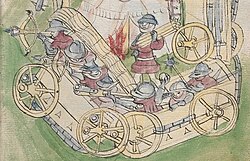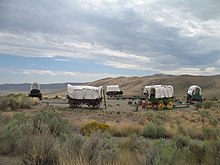
The Battle of Berestechko was fought between the Cossack Hetmanate and Crimean Khanate against the Polish–Lithuanian Commonwealth as a part of the Khmelnytsky Uprising. Near the site of the present-day city of Berestechko in Ukraine, a forces of the Zaporozhian Cossacks and Crimean Tatars under the command of Hetman Bohdan Khmelnytsky, Otaman Tymofiy Khmelnytsky, Colonels Ivan Bohun and Fylon Dzhalaliy with Khan İslâm III Giray and Tugay Bey, who was killed in the battle, was defeated by the Polish–Lithuanian Commonwealth’s forces under the command of the Polish King John II Casimir, Prince Jeremi Wiśniowiecki, Hetmans Marcin Kalinowski and Stanisław Lanckoroński. The battle took place in the Volhynian Voivodeship on the hilly plain south of the Styr River. The Polish–Lithuanian camp was on the Styr River opposite Berestechko and faced south, towards the Zaporozhian Cossacks about two kilometers away, whose right flank was against the Pliashivka (Pliashova) River and the Crimean Tatars on their left flank. It is considered to have been among the largest European land battles of the 17th century.
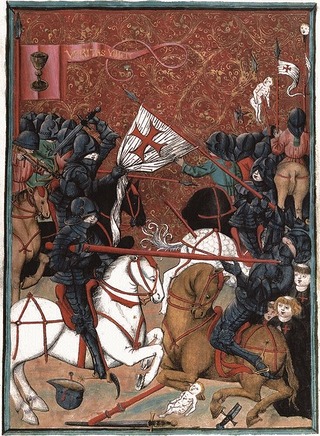
The Hussites were a Czech proto-Protestant Christian movement that followed the teachings of reformer Jan Hus, who became the best known representative of the Bohemian Reformation.

Valentinian I, sometimes called Valentinian the Great, was Roman emperor from 364 to 375. He ruled the Western half of the empire, while his brother Valens ruled the East. During his reign, he fought successfully against the Alamanni, Quadi, and Sarmatians, strengthening the border fortifications and conducting campaigns across the Rhine and Danube. His general Theodosius defeated a revolt in Africa and the Great Conspiracy, a coordinated assault on Roman Britain by Picts, Scoti, and Saxons. Valentinian founded the Valentinianic dynasty, with his sons Gratian and Valentinian II succeeding him in the western half of the empire.

The Battle of Lipany, also called the Battle of Český Brod, was fought at Lipany 40 km east of Prague on 30 May 1434 and virtually ended the Hussite Wars. An army of Moderate Hussite nobility and Catholics, called the Bohemian League, defeated the radical Taborites and Orphans led by Prokop the Great, the overall commander, and by Jan Čapek of Sány, the cavalry commander.

A fortification is a military construction designed for the defense of territories in warfare, and is used to establish rule in a region during peacetime. The term is derived from Latin fortis ("strong") and facere.
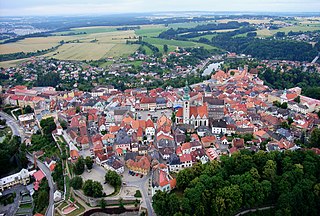
Tábor is a town in the South Bohemian Region of the Czech Republic. It has about 34,000 inhabitants, which makes it the second most populated town in the region. The town was founded by the Hussites in the 1420. The historic town centre is well preserved and is protected by law as an urban monument reservation.

Jan Žižka z Trocnova a Kalicha was a Czech general – a contemporary and follower of Jan Hus and a Radical Hussite who led the Taborites. Žižka was a successful military leader and is now a Czech national hero. He was nicknamed "One-eyed Žižka", having lost one and then both eyes. Jan Žižka led Hussite forces against three crusades and never lost a single battle despite being completely blind in his last stages of life.

The Hussite Wars, also called the Bohemian Wars or the Hussite Revolution, were a series of civil wars fought between the Hussites and the combined Catholic forces of Holy Roman Emperor Sigismund, the Papacy, and European monarchs loyal to the Catholic Church, as well as various Hussite factions. At a late stage of the conflict, the Utraquists changed sides in 1432 to fight alongside Roman Catholics and opposed the Taborites and other Hussite spin-offs. These wars lasted from 1419 to approximately 1434.
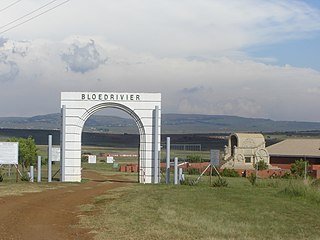
The Battle of Blood River was fought on the bank of the Ncome River, in what is today KwaZulu-Natal, South Africa between 464 Voortrekkers ("Pioneers"), led by Andries Pretorius, and an estimated 10,000 to 15,000 Zulu. Estimations of casualties amounted to over 3,000 of King Dingane's soldiers dead, including two Zulu princes competing with Prince Mpande for the Zulu throne. Three Voortrekker commando members were lightly wounded, including Pretorius.
The year 1838 was the most difficult period for the Voortrekkers from when they left the Cape Colony, till the end of the Great Trek. They faced many difficulties and much bloodshed before they found freedom and a safe homeland in their Republic of Natalia. This was only achieved after defeating the Zulu Kingdom, at the Battle of Blood River, which took place on Sunday 16 December 1838. This battle would not have taken place if the Zulu King had honoured the agreement that he had made with the Voortrekkers to live together peacefully. The Zulu king knew that they outnumbered the Voortrekkers and decided to overthrow them and that led to the Battle of Blood river.

The Battle of Vyšehrad was a series of engagements at the start of the Hussite War between Hussite forces and Catholic crusaders sent by Emperor Sigismund. The battle took place at the castle of Vyšehrad from 16 August 1419 to c. 1 November 1420.

The Taborites, known by their enemies as the Picards, were a faction within the Hussite movement in the medieval Lands of the Bohemian Crown.
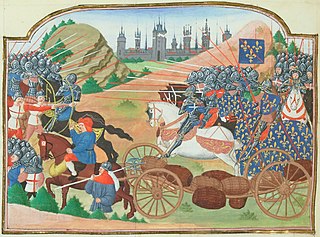
The Battle of the Herrings, also called the Battle of Rouvray, was a military action near the town of Rouvray in France, just north of Orléans, which took place on 12 February 1429, during the siege of Orléans in the Hundred Years' War. The immediate cause of the battle was an attempt by French and Scottish forces, led by Charles of Bourbon and Sir John Stewart of Darnley, to intercept a supply convoy headed for the English army at Orléans. The English had been laying siege to the city since the previous October. This supply convoy was escorted by an English force under Sir John Fastolf and had been outfitted in Paris, from whence it had departed some time earlier. The battle was decisively won by the English.

The Wagon Box Fight was an engagement which occurred on August 2, 1867, in the vicinity of Fort Phil Kearny during Red Cloud's War. A party of twenty-six U.S. Army soldiers and six civilians were attacked by several hundred Lakota Sioux warriors. Although outnumbered, the soldiers were armed with newly supplied breech-loading Springfield Model 1866 rifles and lever-action Henry rifles, and had a defensive wall of wagon boxes to protect them. They held off the attackers for hours with few casualties, although they lost a large number of horses and mules driven off by the raiders.
A war wagon is any of several historical types of early fighting vehicle involving an armed or armored animal-drawn cart or wagon.
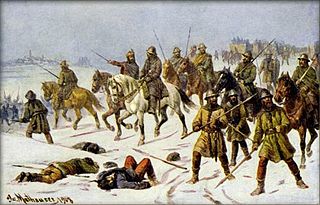
The Battle of Kutná Hora (Kuttenberg) was an early battle and subsequent campaign in the Hussite Wars, fought on 21 December 1421 between German and Hungarian troops of the Holy Roman Empire and the Hussites, an early ecclesiastical reformist group that was founded in what is now the Czech Republic.
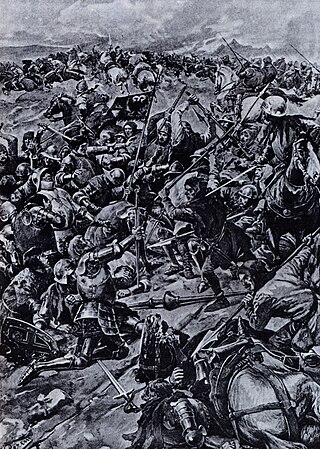
The Battle of Aussig was fought on 16 June 1426, between Roman Catholic crusaders and the Hussites during the Fourth Crusade of the Hussite Wars. It was fought near Aussig in northern Bohemia.
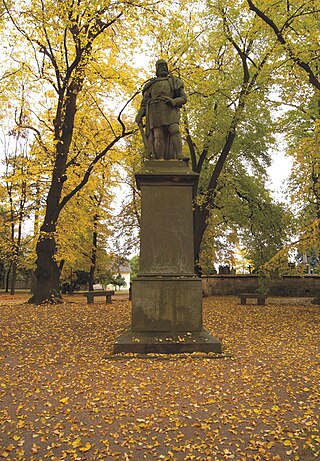
The Battle of Hořice was fought on 27 April 1423, between the Orebites faction of the Hussites and Bohemian Catholics. The Hussites were led by Jan Žižka, while the Catholics were led by the repeatedly-converting Čeněk of Wartenberg. The battle took place on the Gothard plateau, near Hořice. Thanks to a strategic position, which allowed perfect use of Hussite war wagons and Žižka's tactical skills, the Hussites eventually won the battle.

Gulyay-gorod, also guliai-gorod, was a mobile fortification used by the Russian army between the 16th and the 17th centuries.

A Zwinger is an open kill zone area between two defensive walls that is used for defensive purposes. Zwingers were built in the post-classical and early modern periods to improve the defence of castles and town walls. The term is usually left untranslated, but is sometimes rendered as "outer courtyard", presumably referring to the subsequent role of a Zwinger as a castle's defences became redundant and it was converted into a palace or schloss; however, this belies its original purpose as a form of killing ground for the defence. The word is linked with zwingen, "to force", perhaps because the Zwinger forced an enemy to negotiate it before assaulting the main defensive line. Essenwein states that the "main purpose of this feature was so that the besieging force could not reach the actual castle wall very easily with battering rams or belfries, but had to stop at the lower, outer wall; also that two ranks of archers, behind and above one another, could fire upon the approaching enemy".
The Battle of Vegkop, alternatively spelt as Vechtkop, took place on 16 October 1836 near the present day town of Heilbron, Free State, South Africa. After an impi of about 600 Matebele murdered 15 to 17 Afrikaner voortrekkers on the Vaal River, abducting three children, King Mzilikazi ordered another attack. The voortrekkers, under the command of Andries Potgieter, repulsed them, but at the cost of abandoning their livestock.
